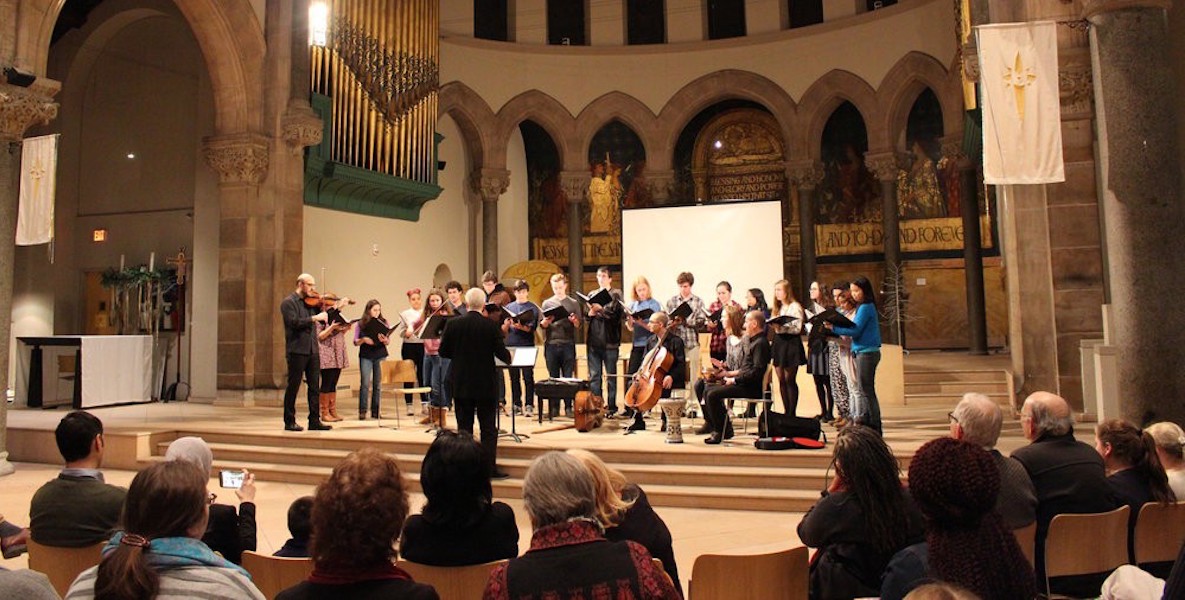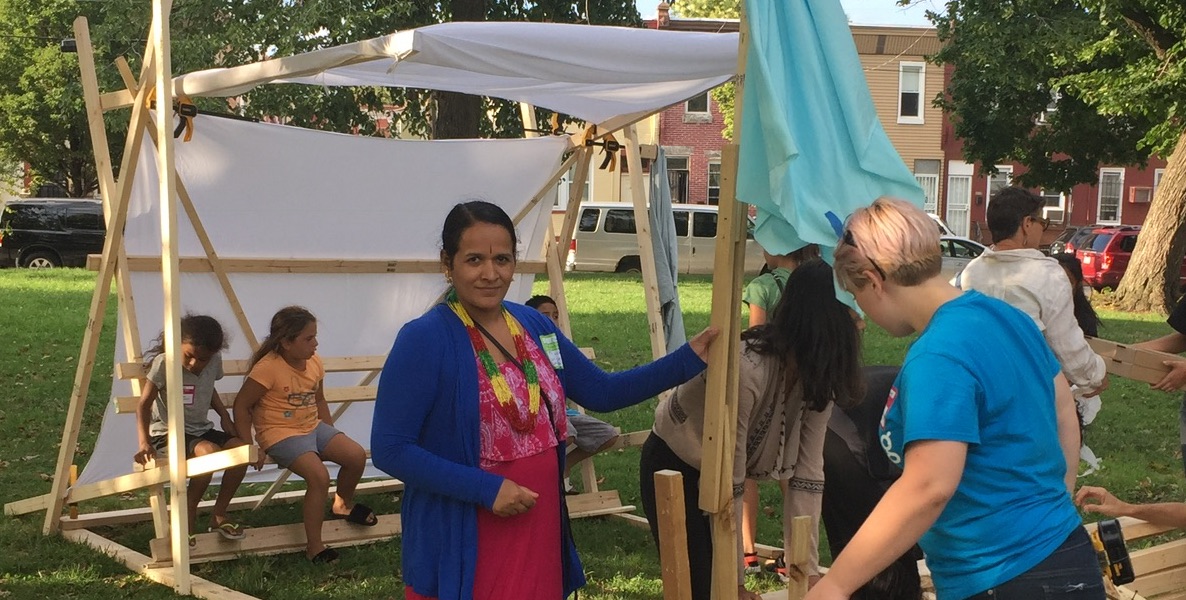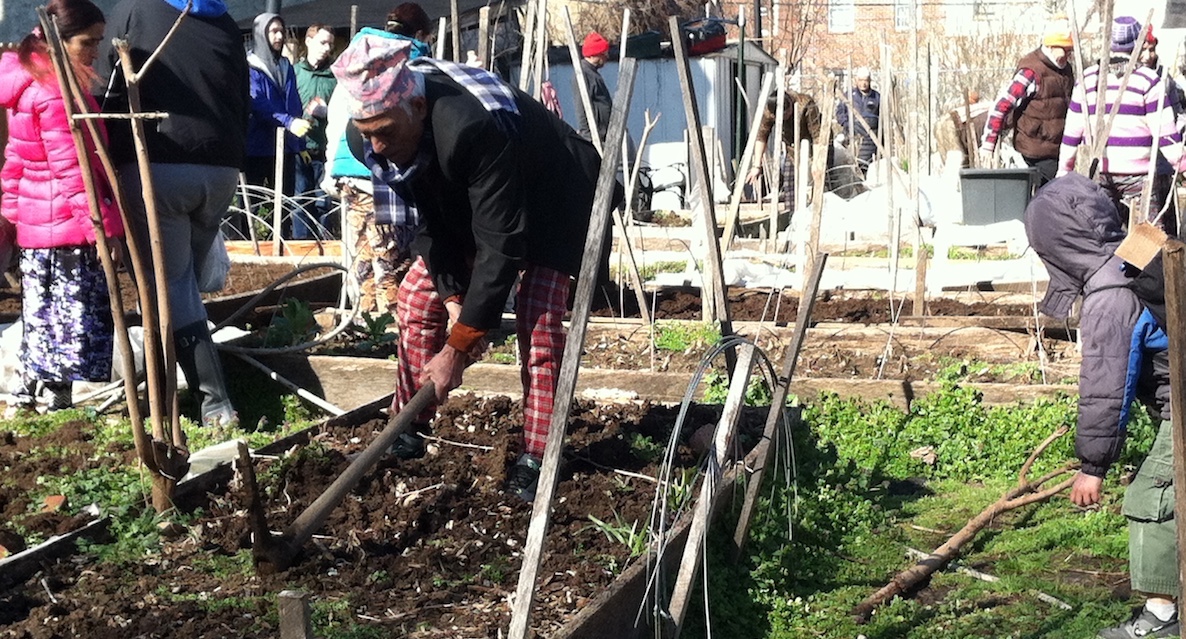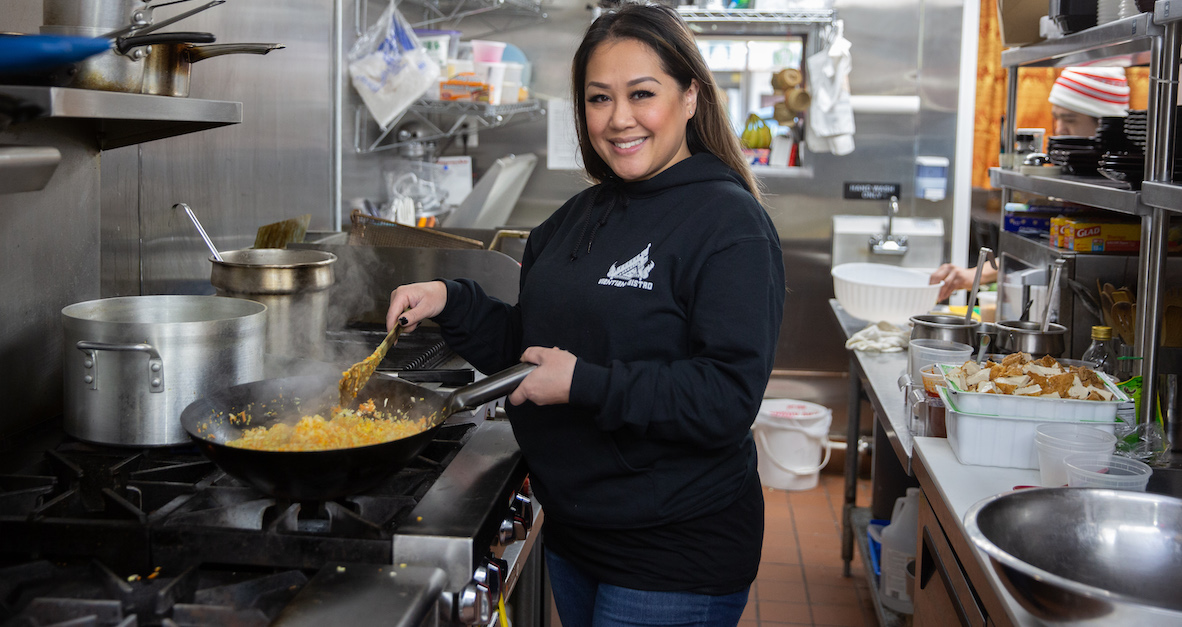When food writing moves beyond the table, however tentatively, into the sticky pots of politics, identity, and culture, food writers always run the risk of being told “stay in your lane” and stick to what’s on the plate. But certain dishes—eaten at certain restaurants at certain moments in time—feel too important to speak about simply in terms of taste.
Such is the case with the spicy, funky, zesty, multi-textured food I’ve been eating ![]() at several new Lao restaurants that have appeared since last summer. It is difficult, for instance, to overstate the cultural and culinary significance of Vientiane Bistro, which opened last fall in Kensington.
at several new Lao restaurants that have appeared since last summer. It is difficult, for instance, to overstate the cultural and culinary significance of Vientiane Bistro, which opened last fall in Kensington.
This is not to ignore the deliciousness of chef Sunny Phanthavong’s traditional Lao cooking: plump grilled pork sausage stuffed with lemongrass and kaffir leaves; funky green papaya salad with padeak, a pungent, chunky, slow-fermented fish paste; the crunchy coconut-fried rice mixed with fresh cilantro, lime, and red pepper, bursting with flavor in the crispy naam lettuce wraps, the earthy, forest-hued stew of shredded bamboo shoots called gang naw mai, full of mushrooms and winter squash and deeply flavored with yanang leaf; unique beef jerky called seen haang, marinated in soy and coriander, to be dipped in a dark, robust chili-peanut-galangal sauce called jaew bong; and of course the sticky rice, grabbed and mushed between your fingers to accompany it all.
I particularly love the khao poon, or “king soup,” a spicy, rich, crimson-tinged stew of rice vermicelli noodles swimming in a coconut broth spiked with red curry, fresh mint and cilantro and teeming with purple cabbage, greens, and minced pork. It’s complex, yet hearty and comforting, and already one of my favorite dishes in the city.
Beyond the food, though, what makes Vientiane Bistro feel important right now is where it sits, at the intersection of big issues like cultural identity, America’s involvement in foreign wars, and the burgeoning nationwide Lao food movement. There’s even significance to Vientiane Bistro’s geographical location—well north of the gentrifying neighborhoods, under the Market-Frankford El on a stretch of Kensington Avenue where it’s common to find heroin addicts nodding off, a reminder that you are close to the epicenter of the city’s painful, crushing opioid problem. The cozy dining room here, with its calm, mellow décor of tan wood and violet-blue, its red-and-gold Lao elephant tapestry, and its tiny wicker sticky rice baskets hanging on walls, bring a warm hopeful vibe to the gritty block.
This is a story about immigrants, particularly the second generation claiming their place in America, and paying it forward. It’s the everyday truth that gets lost in the heated political climate: immigration is the lifeblood of our culture, part of what makes cities like ours such great places to live and visit.
More than anything else, though, this is a story about immigrants, particularly the next generation claiming their place in America, and paying it forward—not just for their own people, but to other new Americans. It’s the everyday truth that gets lost in the heated political climate: immigration is the lifeblood of our culture, part of what makes cities like ours such great places to live and visit.
Vientiane Bistro (opened with partner Kong Tieu) is the sister restaurant of West Philly’s beloved Vientiane Café on Baltimore Avenue, run by Phanthavong’s mother, Daovy, who arrived here in the 1980s as a refugee from Laos’ civil war. “She was always reminding me how lucky I have it,” says 34-year-old Sunny, who was born in the U.S.
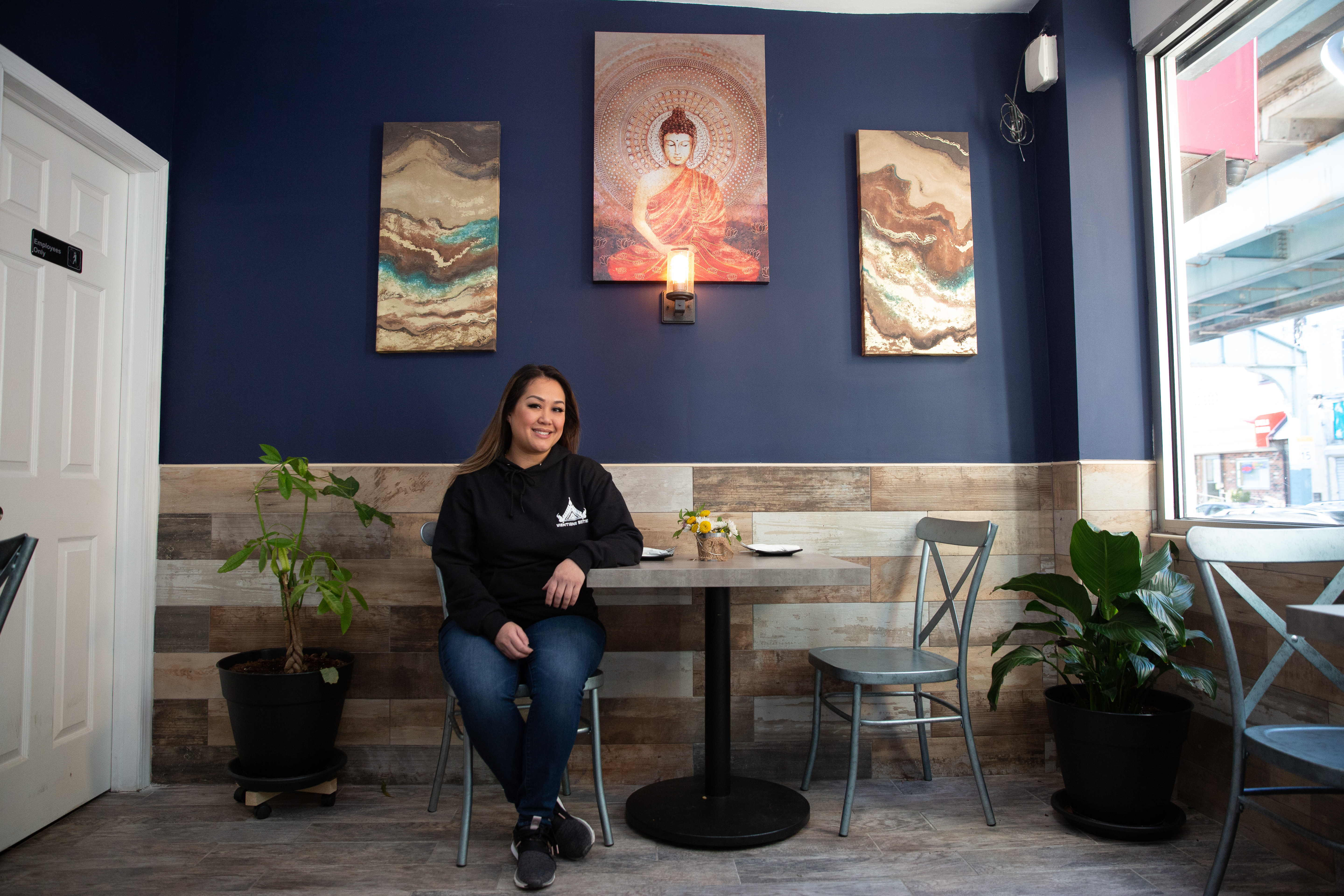
Vientiane Café, named after Laos’ capital city, has been operating officially since 2002. But it began life in the 1990s as an underground, unlicensed spot under a blue tent, mostly for the local Lao community. There may or may not have also been a little drinking and a bit of gambling.
“Eventually someone brought some American friends, and suddenly it was like ‘Yo, there’s some low-key dive in West Philly,’” says Sunny, who cooked and served the food as a teenager during those days. “Eventually, we did get caught.”
One day, a police officer writing a ticket heard a commotion and saw the crowd enjoying the Phanthavongs’ food and hospitality in the backyard under the blue tent. “It was a huge bust,” Sunny says. “A SWAT team came with helmets and guns. I was 14 and had to translate for my parents to the police and the fire marshal.”
“We’re all pushing each other and seeing how we can put our food in the door,” says Sunny Phanthavong. “Lao people are very laid back people, but our generation wants to be part of this revolution. Lao people are coming out of their shells.”
Once the legalities were sorted out, the original Vientiane Café opened as a Laotian-Thai restaurant and offered a menu filled with familiar Thai dishes like curries and pad thai. At older places like Vientiane Café, the most traditional Lao dishes were always available as a sort-of secret menu, with the spice and fish sauce factor turned up. “People in the know would come in and ask, ‘Can I get that Lao funk? Can I get some of that stank stank?’” Sunny says.
For most of the history of Southeast Asian dining in America, Lao cuisine was like a well-ignored secret, confused for the staple of Thai food found in every American city. Across the country, Lao chefs who’d arrived here as refugees opened restaurants serving Americanized versions of Thai food because that’s what people understood.
“It was just easier to open a Thai restaurant because people knew what Thai food was. It was more about marketing and survival,” says Catzie Vilayphonh, a Philadelphia-based artist who runs Laos in the House, a national organization that promotes storytelling in the Lao-American community. “As a community we sort of have mixed feeling about this identity. Lao people want credit. This shouldn’t be taken by Thai people.”
Some Lao chefs are less diplomatic about what they see as cultural appropriation. “I’m sick and tired of people saying it’s Thai food,” said Kha Vorasarn, who opened his Laos Café off West Passyunk in South Philly last summer. “People take everything that belongs to us and is not theirs. This dates all the way back to the French colonialization of Laos. I’m here to claim what’s mine.”
Vorasarn claims pad thai, for example, is actually Lao and not Thai, and he lists it on his menu in Lao, as khua mee. It’s simpler than the Thai rendition. “It’s Thai people that put peanuts and fancier ingredients in the pad thai,” Vorasarn says. Since the people of northern Thailand, or Isan, are ethnically Lao, and since there are many shared ingredients in Southeast Asian cooking, such lemongrass or thai basil, the origins of many dishes are surely matters of debate. (Lao refers to the ethnicity, while Laotian refers to the country of Laos, which has many ethnicities.)
At Vientiane Bistro in Kensington, Sunny insists on bringing fundamental Lao elements, spicier and funkier, more to the fore. In this way, she represents a new generation of Lao chefs around the country who see themselves collectively as part of a Lao Food Movement. “We’re all pushing each other,” Sunny says. “Lao people are very laid back people, but our generation wants to be part of this revolution. Lao people are coming out of their shells.”
Vientiane Café has been operating officially since 2002. But it began life in the 1990s as an underground, unlicensed spot, mostly for the local Lao community. There may or may not have also been a little drinking and a bit of gambling.
The Lao Food Movement was started by Seng Luangrath, whose first restaurant was actually a Thai place called Bangkok Golden, in the Washington D.C. suburb of Falls Church, Virginia. A few years later, Luangrath had massive success with her second restaurant, an unabashedly Lao place in D.C. proper called Thip Khao (named after the tiny sticky rice baskets). Luangrath has since changed the name of Bangkok Golden to Padaek, after the funky Lao fish sauce.
High-profile Lao restaurants have also opened in other cities around the country, including Hawker Fare, in San Francisco, whose chef-owner James Syhabout traveled to Laos with the late Anthony Bourdain during his show’s last season, and published a cookbook on Lao food in 2018. Even Raleigh, North Carolina, has a highly acclaimed Lao restaurant called Bida Manda, opened in 2012 by brother and sister Vansana and Vanvisa Nolintha, with executive chef, Lon Bounsanga, who actually hails from Philadelphia’s Lao community. (In fact, he celebrated the wedding to his first wife at the Phanthavong’s venue in West Philly.)
They went on to open Brewery Bhavana, which was named one of Bon Appetit’s best new restaurants of 2017. “If you had told me seven years ago that Lao food would be so popular, I never would have believed it,” says Bounsanga, whose family arrived in Philadelphia as refugees in 1979. “But everything has its moment. People get bored of certain dishes and they want to taste something new.”

Lao food has subtle but significant differences from other Southeast Asian cuisines. “A lot of newcomers don’t like the taste of fish sauce,” says Bounsanga. Yet a dish redolent with fish sauce such as laap—minced pork, beef, or chicken tossed with lime juice, chillies, and herbs like lemongrass, kaffir, and cilantro—is one Lao dish that’s leaped into mainstream popularity. The dish is often listed on menus as laab or larb. Sunny Phanthavong explains that “Laap sounds more like our native tongue, but somehow we kept the ‘b.’” So laab is okay, she says, but larb is totally incorrect.
You can compare the differences in spice and funk clearly at a restaurant like Maliwan, which opened last summer at Sixth and Morris in the old Khmer Kitchen space. Yenh Thivarath’s menu is split between Thai and Lao dishes, but while the Thai food here is fine, I would go back regularly for the Lao dishes: a super spicy Lao-style steak, excellent sticky rice, and a great rendition of laap.
![]()
Of course, “if you’re looking for an adventure, Lao food will definitely give you that,” Sunny says. In the past, in her days at Vientiane Café, she hosted a dinner series called Adventurous Eats that features dishes like fertilized duck eggs, river snails, grilled chicken hearts, insects, and omelets stuffed with silkworms. This sort of exoticizing of Lao cuisine can only be pulled off by a Lao chef.
“Adventurous eating” is put into perspective one quiet afternoon recently at Laos Café in South Philly, where I eat a lunch of fried crispy duck feet along with an amazing soup called khao piak sen, with thick, translucent, udon-like noodles made from a unique mix of tapioca and rice flour. Catzie Vilayphonh of Laos in the House had told me that this might be the most authentic dish I could get, because the noodles had to be homemade.
On that cold afternoon, as I eat the steaming, comforting khao piak sen, I understand that this is about more than just food. One of Laos in the House’s volunteers, a Lao-American woman named Leona comes in to get takeout. As Leona waits for her food, she gossips with the high-school aged Lao server about a woman they both know, and the server tells Leona about her own summer trip to Argentina to visit her grandmother. Leona sees me listening and explains that when refugees of Laos’ civil war were resettled, they were sent to whatever country could take them. “This was the first time I ever met my grandmother,” the server tells me.

Leona tells me about the Lao new year, which will be celebrated in April at the Lao temple in South Philly, and about a planned almsgiving at the temple, a huge spread of traditional Lao food brought for the monks. She points out a statue of three white elephants on the shelf behind me and tells me that the original Laos flag, until 1975, had these three elephants under a parasol. “That’s the only flag my dad would ever fly,” she says.
![]()
Vorasarn, the chef, pops out and Leona tells him about an upcoming event, with the Lao-American author of a children’s book called Mommy Eats Fried Grasshoppers, a story about cross-cultural acceptance. Leona says she was once skeeved out when someone had her eat a live silkworm.
“I’ve eaten them before,” Vorasarn says, with a shrug. “Not anymore, but when I was a kid in the refugee camp in Thailand, in 1977, 1978. At that time they tasted amazing. I was sent out to dig up beetles, worms, grasshoppers, all kinds of bugs.”
At the mention of the refugee camp, I can’t help but think about how shameful it is that most Americans know so little about Laos. After all, it’s where our own country waged the CIA-backed Secret War, the largest covert military action in our history. We dropped more bombs on Laos in the 1970s than were dropped in all of World War II. There are still millions of unexploded ordnance in rural Laos that maim people to this day. Considering all that, I believe the Lao refugees who made it here, immigrant Americans who have worked hard and raised their families and prospered—and a few of whom have now opened these amazing Lao restaurants—must be among the most forgiving people on the planet.
“Even though we were resettled here, it’s not like we were welcomed,” she tells me. “Now that I’m grown up and aware of my family’s history, how can I help other people going through similar immigrant experiences?”
Later, when I spoke with Catzie Vilayphonh of Laos in the House, she told me about how she would be helping out with a fundraiser for undocumented workers run by her friend, Cristina Martinez of Barbacoa, whose own rise from undocumented Mexican immigrant to acclaimed chef is a story of our times. The event, in mid-January, raised money for the city’s undocumented workers.
Vilayphonh was born in a Lao refugee camp in Thailand before her family came to the U.S. “Even though we were resettled here, it’s not like we were welcomed,” she tells me. “Now that I’m grown up and aware of my family’s history, how can I help other people going through similar immigrant experiences?”
The Lao dish that Vilayphonh contributed to the fundraiser is called mieng muang luang—a savory sticky rice lettuce wrap that is rarely on restaurant menus because it’s way too labor-intensive to make to order. “To do it properly from scratch, it takes two days,” she says. “When you take a bite you’re supposed to taste all of the flavors of Laos.”
Jason Wilson is The Citizen’s 2019 Jeremy Nowak Fellow, funded by Spring Point Partners, in honor of our late chairman Jeremy Nowak. He is the author of three books, including most recently Godforsaken Grapes, series editor of The Best American Travel Writing, and writes for the Washington Post, New York Times, New Yorker and many other publications.
Photo by Anthony Pezzotti


